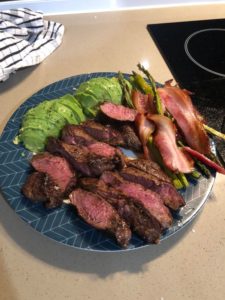What Is OMAD
The OMAD (One Meal A Day) diet is a type of intermittent fasting that focuses on eating just one meal a day, usually at the same time each day, and fasting for a full 24 hours until your next meal.
While it may sounds simple, there’s a lot of things that make this a little more complicated than what’s on the surface.
It’s recommended that each meal should be within the same four hour time block as the one you had on the day before, which can be difficult with changing schedules and different types of access to certain foods. Furthermore, you can only limit your beverage consumption to those without calories between fasts, such as water and coffee (that means no keto-friendly bulletproof coffee, unfortunately).
Depending on who you ask, OMAD was generally founded around the idea that the one meal you’re eating must also be able to fit onto one dinner plate, and some extreme OMAD followers only allow the food to reach up to three inches in height off of the plate – so you can’t go crazy with the portions either.
With that, when you’re using OMAD on the keto diet, you don’t really have to worry about calories as much, because you’re already restricting your carb intake and your eating to a certain time frame and volume.
The options are ultimately personal though, and it’s best to do what feels right for you. Some people use this method every day until they hit their weight loss goals, and others cycle it into their weekly routines to help get most of the benefits of fasting without entirely changing their routines.
What Is Intermittent Fasting?
Intermittent fasting is simply eating and fasting in alternating cycles throughout the day. It’s primarily used as a way to lose weight, improve metabolic health, boost cognitive function, and protect against certain types of degenerative diseases.
There are a few different types of intermittent fasting to choose from, including the 16:8 method, the Warrior Diet, Eat-Stop-Eat, The 5:2 diet, and of course, the one meal a day diet (OMAD).
Most people find the 16:8 method to be the easiest, and I think it’s a great way to start to get your body accustomed to the process of fasting, but most keto dieters see the most effect from the OMAD diet. I’ll explain why below.
Benefits of OMAD on Keto
-
Improves Cognitive Function
Fasting for the majority of a day has been proven to greatly improve one’s general cognitive functioning.
Recent studies have determined that fasting for extended periods of time between meals can stimulate production of a protein called BDNF, which has been directly linked to improved memory and learning skills by actually strengthening the neural pathways that make up your brain.
It’s also been shown to have a potential beneficial effect for those struggling with cognitive diseases like Alzheimer’s and Dementia, as it can help repair broken neural pathways as well. It’s not necessarily a cure for either of these, but the science does support using fasting to both treat the conditions and prevent them from developing in the first place.
-
Speeds Up Fat Loss
Both the ketogenic diet and intermittent fasting individually have widely been proven to be great catalysts for speeding up fat burning processes within the body. When these two habits are combined, they can be even more powerful.
Our bodies react in a very specific way when we restrict our window of eating calories to a very small time frame. This effect usually results in rapid burning of body fat, even when our bodies aren’t necessarily in a calorie deficit.
When combining fasting with the keto diet, our bodies are already in a state ready to burn fat because of ketosis, so there won’t be as much of a delay for results from fasting as there would be for someone not following a low carb diet.
-
Stabilizes Blood Sugar Levels
This is a great one for both keto dieters and for those who are struggling with type 1 or type 2 diabetes.
A few studies have connected fasting with an overall more improved heart health and generally stabilized blood sugar levels. This is largely due to the reduced glucose levels that take place when we’re fasting, resulting in a usual improvement our body’s efficiency with insulin.
Newer research from Harvard also suggests that the exact timing of the fast is key, which is why OMAD might be more likely to be used when it comes to managing spikes in blood glucose and insulin levels.
-
Simple and Easy to Follow
This one can be seen as a benefit or a drawback depending on how you look at it, but what I love about OMAD is that it’s convenient, and takes a ton of thinking about meals out of the equation.
I’m a pretty busy guy, and my busy schedule was one of the main lame excuses I’d give myself when it came to my weight loss journey. OMAD was a great way around that, because I was able to just follow my one meal a day, eat a ton during that meal, and not have to think about cooking or snacking until it came time to prep for the next meal.
-
Promotes Autophagy
Autophagy is a significant benefit of most different types of fasting. It refers to the process in which our bodies recycle old and defect tissues and cells, and generate new ones in their places.
One of the biggest factors that the efficiency of autophagy depends on is insulin, and when your insulin levels are completely stable through low blood glucose levels from fasting, autophagy can take place a lot more quickly. This is because the longer you fast, the lower your insulin is, so one meal a day is the absolute perfect fasting method in this case.
Side Effects of OMAD on Keto
-
Can Lead to Overeating
This one’s a tricky one. While it is true that you’re less likely to need to worry about caloric deficits when following an OMAD type of fast on keto, those calories can still quickly add up (and so can the net carbs) if you’re not careful.
When first starting out, some people’s eyes might be bigger than their stomachs. There’s a lot of anxiety that comes with knowing you won’t be eating again for another 24 hours, so it’s natural to want to get as much food into your system as possible.
But it’s clear to see that this is where slip ups can happen, so it’s important to stick to a calorie/macronutrient tracker when following the OMAD diet, just to be safe.
-
Can Result in Lack of Energy
Lack of energy is one of the most frequently reported issues with one meal a day plans, and they make sense. Not everyone’s bodies behave the same, especially if you’re still early in the keto diet and experiencing symptoms of the keto flu.
Restricting your eating window while on the keto flu is a sure way to exacerbate the symptoms, and make you feel groggy and sluggish all day.
Another reason people experience this state is because they’re not factoring in getting enough electrolytes. People spend so much time worried about hitting macros, they forget that they need daily sources of sodium, potassium, and magnesium, especially when on the keto diet.
-
Risk of Not Eating Enough
Just like overeating, there’s also a pretty clear risk of not eating enough when you’re restricting yourself to just one meal a day. If you’re eating too quickly, you might feel fuller faster, and not be able to finish your meal, meaning your body will be running on a much lower amount of nutrients than it needs to function at its full potential.
Another part of this is with the modern three meal diet and snacks that most people are accustomed to, it can be hard to know exactly how much to portion for your one meal a day. That’s why I included some of my favorite OMAD meal plans at the end of this article.
-
Can Lead to Eating Unhealthy Options
This one’s tricky, even for keto dieters. It’s very easy to overdo it on cheeses and creams, which while they are essential parts of the keto diet, they can make you full really quick, and make it harder to find motivation to eat things that are less tasty but nevertheless essential.
Eating one meal a day also usually makes us want to indulge in food that’s bad for us, because we’re expecting something good for fasting for so many hours without any sort of reward or stimuli.
But if you can push past this and stick to a plan, you can easily be successful with OMAD on keto. I’ll break down the best way to get started next.
How to do OMAD the Right Way
-
Ease into it by starting slow
This type of intermittent fasting when combined with keto might not be for everyone, which is why it’s advised to consult with a doctor first if you have any concerns before diving into the OMAD and keto combination.
If you’re completely new to intermittent fasting you may want to work your way up to one meal a day with a couple of other effective methods. The 16:8 fasting protocol is a great example, because it can teach you the framework of fasting without completely uprooting your eating habits and lifestyle.
If you’d still rather go all in on OMAD despite being new to fasting, you’ll want to pay close attention to the next few tips as well.
-
Don’t Forget About Electrolyte Replenishment
Electrolytes are absolutely essential when it comes to the keto diet, especially when you’re limiting your eating time to a very isolated window. It can be easy to forget to get all of the essential electrolytes into your meal when calories and macro counts tend to take priority for most people, but it’s wise to always keep them in mind.
Replenishing electrolytes regularly is one of the best ways to avoid the unwanted side effects of keto, especially when first starting out, such as the insomnia, fatigue, and nausea of the keto flu.
I like to replenish my electrolytes through supplements when I’m on fasts, because they don’t break fasts, and still provide everything you need. I usually pick mine up over at Amazon.com.
-
Remember to prep your meal for the day in advance
If you’re going into the one meal a day plan with keto, you’re going to definitely need a plan to stick to. One of the biggest mistakes that people make is improvising when it comes to their OMAD meals. Having a meal prepped in advance is a great way to know exactly how much you’re consuming, what exact macros and nutrients you’re getting, and it’s easier to track than if you were to just mindlessly snack during your meal time.
Planning these meal prep options can be tough, so I’ve included some of my favorite plans at the end of this post.
-
Eat Slowly
Eating slowly can be pretty challenging, especially at the end of a day long fast when all you’ve been thinking about is your next meal. However it’s an important part of OMAD on keto.
Eating slower has proven benefits for your digestion, and can help you feel fuller longer, which is the entire name of the game when it comes to managing your fasting routine.
It’s so effective because when you chew slower, your saliva enzymes are given more time to penetrate the food you’re eating, which makes them a lot more digestible and easier on your digestive system in the long run.
-
Make a meal plan with variety
This one’s not as essential, but it’s a very helpful way to be sure to stick to this plan in the long run. It’s easy enough to get burnt out on the idea of only eating one meal a day, but if it’s also the SAME meal a day, the temptations to quit are only going to keep getting stronger and stronger.
I’ve found a few great, diverse OMAD meal plans that I’ve put into action and personally love, and I hope you’ll try them and enjoy them too.
Keto OMAD Meal Plans
-
Meal 1

400g eye fillet, seasoned with salt and pepper and cooked nicely on a cast iron skillet after being basted in butter and garlic. 1 whole avocado on the side that’s also seasoned in salt and pepper, along with 6 asparagus stalks that are individually wrapped in in bacon.
The approximated macros for this meal are 176g protein 6g net carb 107g fat.
-
Meal 2
Reddit user Wescuddles provided this one, and it’s super nutritious and tasty at the same time:
“Set oven to 375 and put four sausages (375g eaach) in an open dish for 25 min. While your sausages are cooking slice up your mushrooms (1 cup) and dice half an onion. Throw down a layer of mushroom, onion and roughly half of a cup of Gouda. Flip your sausages at 25 and set for another 15. Throw your mushroom goodies into another dish and put them in when the timer goes off. Set another timer for 10 min. Pull out your sausages and let them rest. While they rest broil your mushrooms on high for 2-3 min”
In total from that, you’ll be getting 165g fat (72%), 22g carbs (4%) and 123g protein (23%).
-
Meal 3
Fathead Pizza! Reddit user Very_Ape1979 inspired this great recipe:
When making the dough, you’ll need
-
- 100g Mozzarella
- 25g Cream Cheese
- One Large Egg
- 50 grams of Almond Flour
- 1/4 teaspoon of Salt and Garlic Powder
For toppings, you’ll need:
-
- 46g Chorizo
- 91g Bratwurst
- 25g Passata
- 25g Kalamata Olives
- 30g Jalapeños
- 30g Red Onion
- 35G Sweet and
- Sour Pickle
- 100g Mix of mozzarella and Cheddar
The prepearation is pretty simple too:
Microwave the cheeses for 1 minute add salt, Garlic powder and Almond flour then mix well and microwave again for 30 secs. Let it cool to the touch then add egg and mix again. Let it rest for 5 mins then put it on parchment paper and place some on top a roll it till it’s pretty thin.
Put in oven at 390 degrees for around 10 to 15 mins then remove. Flip over and put the toppings on top and place under the grill/broiler till melty brown!
Macros for this meal are as follows:
-
- 1676 Calories
- 92.4g Protein
- 16.1g Carbs.
- 140.5g Fat

